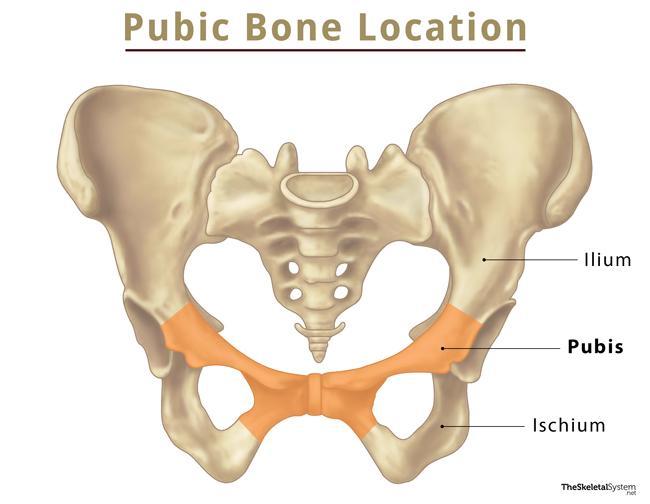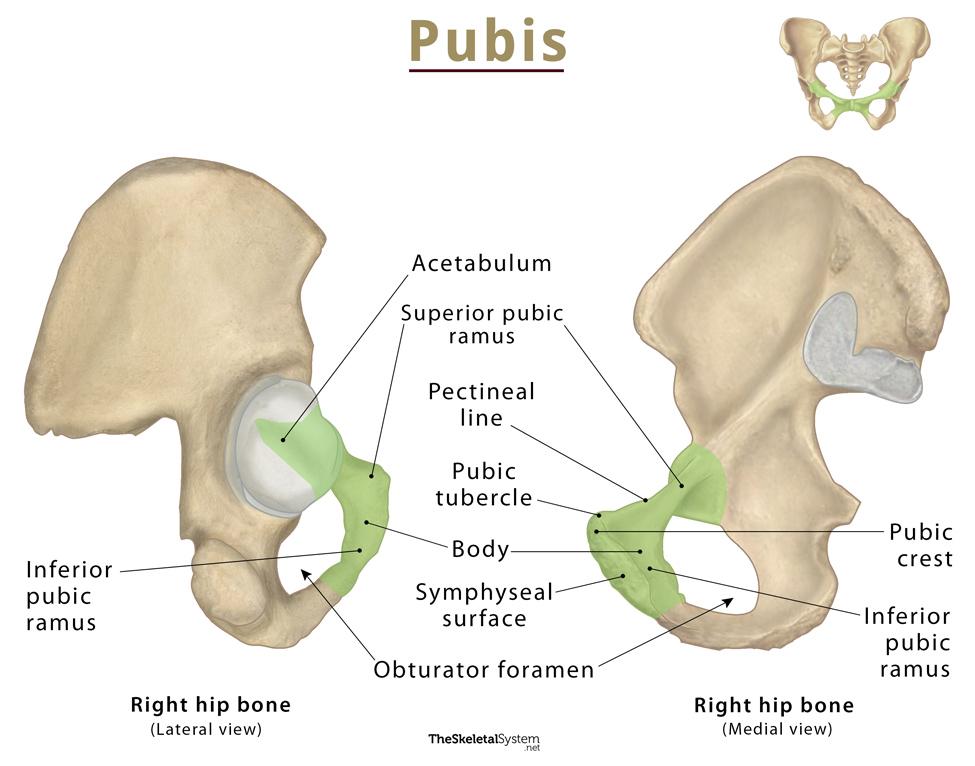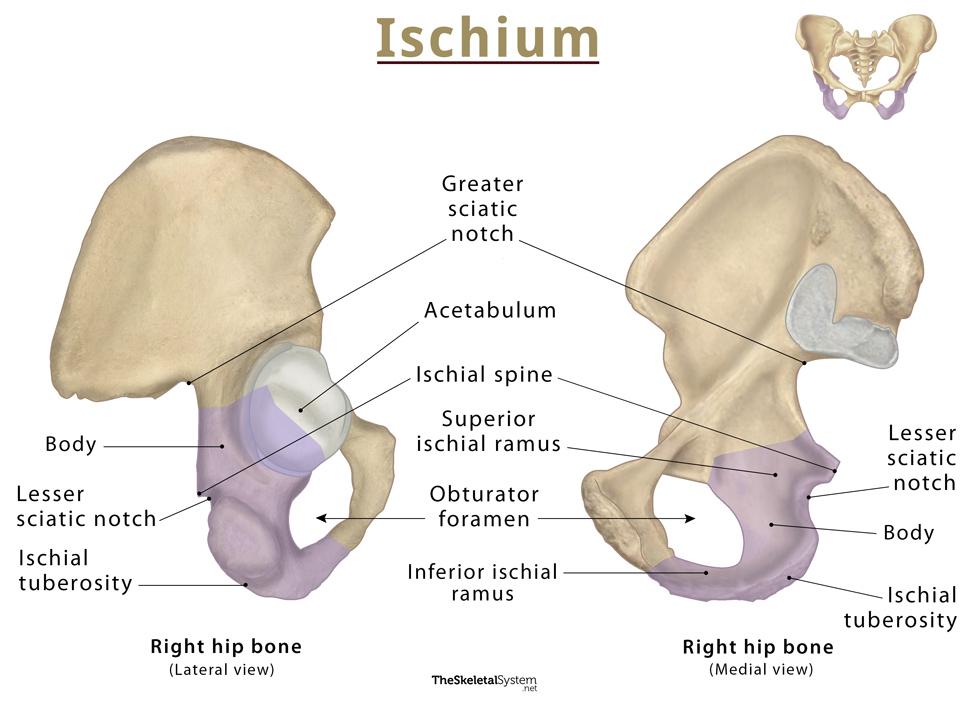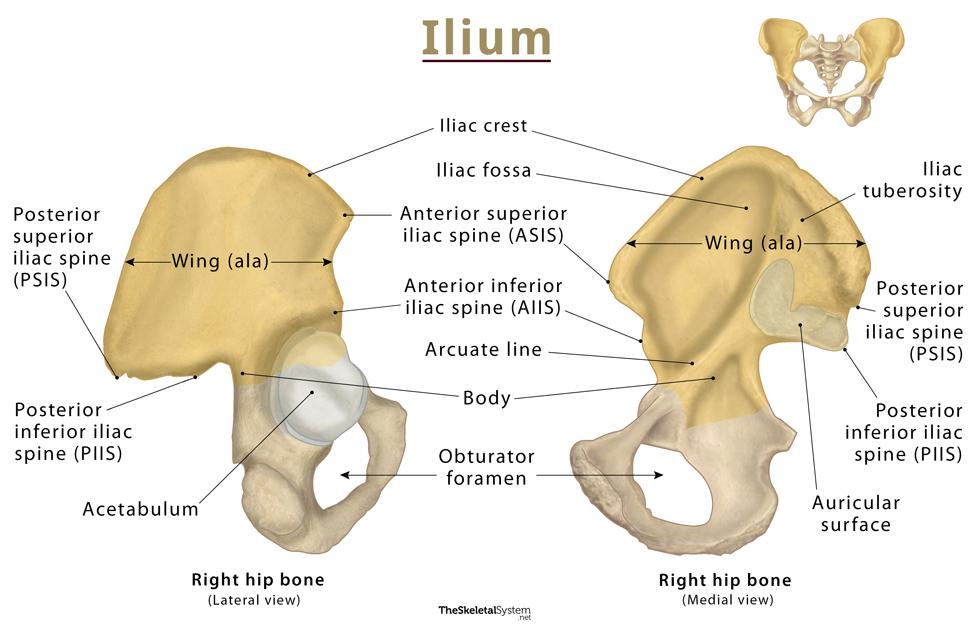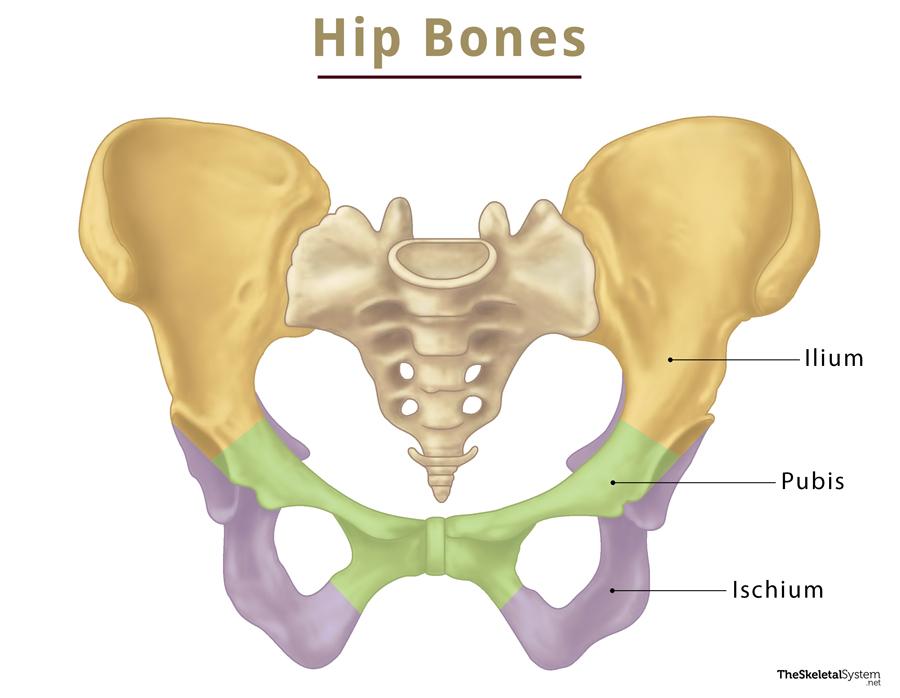Pubis (Pubic Bone)
What is the Pubis
The pubis is one of the three bones that fuse to form the hip bone, the other two being the ilium and ischium. It is the front portion of the hip bone.
Where is the Pubic Bone Located
The pubic bone is located at the front of the hip bone, close to the genitals.
Quick Facts
| Type | Irregular bone |
| How many are there in the human body | 2 (1 on each side) |
| Articulates with | Ilium and ischium |
Functions
As it is a part of the pelvis, it protects several vital organs in the abdominal cavity, such as the urinary bladder and reproductive organs.
Parts and Anatomy
The pubic bone or pubis is the smallest component of the hip bone. It has a small body located anteromedially and two rami, superior pubic ramus and inferior pubic ramus, extending posterollatery from the body. The rami of the pubic bone look like the letter ‘K’ from an anterior view. Together, these two rami enclose part of the obturator foramen through which the obturator nerve, artery, and vein pass through to reach the lower limb.
1. Body
The body of the pubic bone has three surfaces — anterior (external), posterior (internal), and symphyseal (medial) — that merge, except at the pubic crest located at the anterosuperior part of the body. It marks the transition from external to internal surfaces. This crest ends laterally as the pubic tubercle, where the medial end of the inguinal ligament attaches.
External (Anterior) Surface: The smooth anterior surface faces the inferolateral side. The adductors of the thigh attach here.
Internal (Posterior) Surface: This surface faces posterosuperiorly, forming the anterior wall of the lesser pelvis.
Symphyseal (Medial) Surface: The medial surface of the pubic bone of left and right hip bones articulate with each other via symphyseal cartilage, forming the pubic symphysis joint. The curved area below the pubic symphysis is known as the pubic arch, one of the sexually dimorphic areas of the pelvis. In males, the arch is v-shaped, whereas, in females, it is usually broader.
Pubic Crest: The superior aspect of the body is marked by a rounded thickening called the pubic crest. This crest separates the anterior and posterior surfaces of the bone. On its lateral end, the pubic crest features the pubic tubercle. This tubercle serves as a point of attachment for the inguinal ligament.
2. Superior Pubic Ramus
The superior pubic ramus is one-third of the pubic bone. It starts at the pubic tubercle and extends posterolaterally and upwards to the acetabulum, joining the ilium and ischium. It appears triangular in cross-section, having three surfaces.
Pectineal (Anterior) Surface: Extending from the pubic tubercle to the iliopubic ramus, this surface is delimited anteriorly by the round obturator crest and by the pectineal line or pecten pubis posteriorly. The pectineal line is continuous with the arcuate line of the ilium. The pectineal and arcuate lines collectively form the linea terminalis or pelvic brim that separates the greater and lesser pelvis.
Obturator Surface: This surface faces posteroinferiorly and is bounded anteriorly by the obturator crest and inferiorly by its sharp inferior border.
Pelvic surface: The pelvic surface is relatively smooth and faces posterosuperiorly. It is limited by the pecten pubis above and the inferior border below.
3. Inferior Pubic Ramus
The inferior pubic ramus is thin and flat, making up one-third of the pubis. It passes laterally and downward from the medial end of the superior ramus and becomes narrower as it descends to unite with the ischial ramus to complete the obturator foramen. It has two surfaces, anterolateral and posteromedial, which remain separated by the anterior and medial margins.
Anterolateral Surface: It is directed towards the thigh, running superiorly to the body of the pubis.
Posteromedial Surface: This surface faces the lesser pelvis, where the crus of the penis (males) or clitoris (females) attach.
Articulations
- The pubic bones of the left and right hip articulate through a cartilaginous joint called the pubic symphysis.
- The bone also fuses with the other two components of the hip bone, ilium, and ischium.
Muscle and Ligament Attachments
Several vital muscles and ligaments insert or originate from the pubic bone.
Muscles
Originating from the pubis
- Gracilis and adductor brevis muscle: From the external surface of the body and inferior ramus
- Obturator externus muscle and obturator internus muscle: From the external surface of the body
- Adductor longus: From the upper body of the pubis just below the pubic crest
- Pectineus muscle: From the external surface of the superior ramus
- Sphincter urethrae: From the conjoint ramus
Inserting into the pubis
- Rectus abdominis muscle: On the lateral side of the pubic crest
- Pyramidalis muscle: Just below the attachment of the rectus abdominis muscle
- Levator ani muscle (levator prostatae and puborectalis): on the medial surface of the body
Ligament Attachments
- Pubofemoral and obturator ligament: At the obturator crest.
- Inguinal ligament (Poupart ligament): At the pubic crest.
- Ventral pubic ligament: At the medial aspect of the anterior surface of the body.
- Puboprostatic ligament: At the pelvic surface of the body.
- Lacunar and pectineal ligament: At the pecten pubis.
References
- Pubis – Radiopaedia.org
- The Hip Bone – Teachmeanatomy.info
- Hip bone – Kenhub.com
- Bony pelvis – Kenhub.com
- Pubic Bone – Sciencedirect.com

